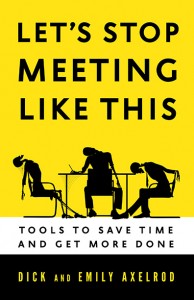 The new book, Let’s Stop Meeting Like This: Tools to Save Time and Get More Done,” should become a go-to resource for anyone who wants to improve meetings.
The new book, Let’s Stop Meeting Like This: Tools to Save Time and Get More Done,” should become a go-to resource for anyone who wants to improve meetings.
Authors Dick and Emily Axelrod can help you reduce meeting pain three ways:
First, they show you how to use their proven Meeting Canoe system, a lean approach to running meetings. The meeting canoe is an agile, repeatable process that ensures you can structure your meetings from end-to-end starting with the way you greet people at the beginning to how you wrap up at the end so works gets done there. Plus, you can make sure to use everyone’s time well so time is valued not wasted. (Note: yes, you still need to start planning the meeting experience and agenda way in advance.)
Second, they explain how excellent meetings share five attributes with award-winning video games. When meetings include these attributes—autonomy, meaning, challenge, learning and feedback—you increase your ability to engage participants more fully both in the process as well as the outcomes. Besides being engaged, participants should feel more respected too.
Third, they provide a number of easy-to-use tools, including a “meeting experience questionnaire,” that you can apply immediately. The friendly, straightforward manner in which the authors present these tools makes them especially appealing.
All these features are flexible so you can adapt them to different types of meetings as well as changing conditions. For instance, the principles and tools can work with informal chats and huddles as well as with large multiple-day work groups.
(If you’re conducting an official business meeting for either a nonprofit or for-profit board or delegate assembly, you also can incorporate the principles too. However, those responsible for ensuring compliance with the strict governance requirements may insist upon following more traditional meeting rules. You know you are you, and I would appreciate you acknowledging that I’ve pointed this out.)
Keep in mind that the Axelrods’ meeting canoe shares similarities with a real canoe. The meeting canoe encourages everyone to put a figurative paddle in the water and work together to increase engagement and improve results.
Dick and Emily, who are successful consultants as well as authors and like me, alums of David Rock’s NeuroLeadership Group coaching program, have their feet firmly on the ground with their practical counsel. They recognize that it’s more likely that readers will decide to try pieces of their system or just one or two tools at a time, rather than adopt everything all at once.
That’s a sensible attitude, especially since Let’s Stop Meeting Like This represents a seismic shift to meetings as opposed to set of tweaks, as the Axelrods themselves say.
However, if you can move faster toward implementing their system, you should. It will be easier to stop the meeting pain and increase everyone’s pleasure.
Life is too short to continue to suffer through bad meetings. More times that I like to count, individuals contact me about meeting problems that have been going on for a number of years, which are often related to bad meeting hygiene and the dysfunctional behavior of meeting participants.
As the Axelrods describe, it’s time to “transform mind-numbing, energy-sapping meetings into productive work experiences.”
Even better, if you buy this book on August 4, you can not only improve your meetings but you also can help a worthy cause. The Axelrods are donating a portion of their royalties to The Dreamcatcher Foundation, a not-for-profit organization that fights to end human trafficking in Chicago.
Here’s to the Axelrods for their worthy pursuits and helpful tools!

0 Comments